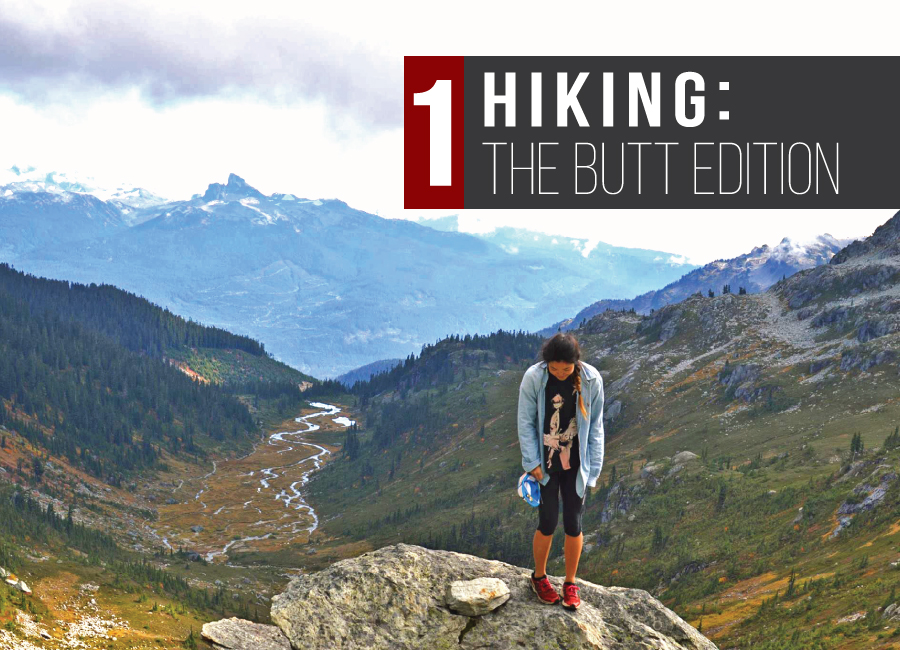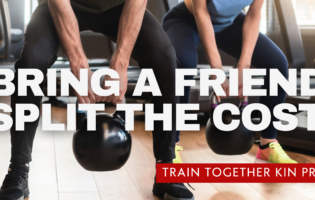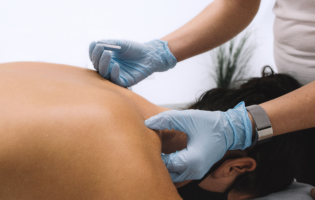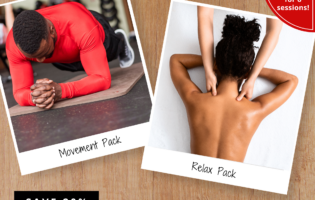Total Therapy Blog

Hiking 1. The Butt Edition
Whether it’s a casual three-kilometer loop at Rice Lake or the Sea-to-Summit trail with a gain of over 900-meters in elevation, Vancouverites love to hike! And why not? The Lower Mainland is riddled with routes (and roots, haha get it?) ranging in all kinds of terrain and difficulty. No matter your level or intentions, Mother Nature has you covered. With so many trails to choose from, we want to help you stay strong and healthy so you can conquer your adventure bucket list this summer!
Series 1: The Butt
“Number one: like yourself. Number two: you have to eat healthy. And number three: you’ve got to squeeze your buns. That’s my formula.” – Richard Simmons
If Simmons and I had anything in common, it would be our belief in the three rules above. That and our sweet style. And we can apply this belief to healthy, injury-free hiking too.
Your butt’s got your back!
I’ve had several friends complain about this early-on in the season. While the view was spectacular and they had an amazing experience, their low backs were giving them grief both during and after the hike. But wait, they’re all in their mid- to late-twenties and seemingly healthy; what gives?! Well, most often it is due to our glutes (or lackthereof).
 Let’s first talk about the gluteus maximus (max): the heavyweight champion of muscles. It is the largest muscle in our body, making it a great source of strength and power. So let’s use them! The glute max are responsible for hip extension so we see them working hard especially during ascending, like climbing all 2,830 steps of the Grouse Grind. It’s not called Mother Nature’s Stairmaster for nothing! Imagine if we didn’t take advantage of our glute max. Other smaller muscles, who are ill-equipped for the long and heavy haul, have to take over for the butt. It’s the perfect storm for undue fatigue, aches, and possibly even injury. The most commonly used muscles to compensate for tired or lazy glutes are the hamstrings and low back extensors. Do chronically tight hamstrings, hamstring strains, and/or low back pain sound familiar? Don’t worry, it’s not always due to lack of strength or endurance! Sometimes it’s just about remembering to use the correct muscle and we need to work on building efficient communication between the brain and that muscle. Either way, getting those glute max active again just might be what your back needs.
Let’s first talk about the gluteus maximus (max): the heavyweight champion of muscles. It is the largest muscle in our body, making it a great source of strength and power. So let’s use them! The glute max are responsible for hip extension so we see them working hard especially during ascending, like climbing all 2,830 steps of the Grouse Grind. It’s not called Mother Nature’s Stairmaster for nothing! Imagine if we didn’t take advantage of our glute max. Other smaller muscles, who are ill-equipped for the long and heavy haul, have to take over for the butt. It’s the perfect storm for undue fatigue, aches, and possibly even injury. The most commonly used muscles to compensate for tired or lazy glutes are the hamstrings and low back extensors. Do chronically tight hamstrings, hamstring strains, and/or low back pain sound familiar? Don’t worry, it’s not always due to lack of strength or endurance! Sometimes it’s just about remembering to use the correct muscle and we need to work on building efficient communication between the brain and that muscle. Either way, getting those glute max active again just might be what your back needs.
Your butt does even more!
We talked about the big guy, the gluteus maximus. We have two more gluteal muscles: medius (med) and minimus (min). This dynamic duo takes on the task of hip stability. During walking, the med and min make sure that the ankle, knee, and hip joints stay aligned so that the force from the impact between the foot and the ground travels up through the strongest part of the body. Inadequate med or min activity may direct the force elsewhere into weaker structures. Often, this is felt in the ankle and knee joints.
 But it’s not just trauma that occurs from this redirection of force. We also see different muscles working overtime to cover up for the med and min. Perhaps you’ve heard of the term “hip drop”? It’s where the hip of the standing leg “gives out” to the side due to weak glute med and min, while the other non-weight-bearing hip drops downwards. This shift in posture can cause muscle tightness in, well, pretty much every major area of the body: IT band, hip flexors, quads, hamstrings, calves, tibialis anterior (think shin splints), lower back muscles, upper back muscles, and even up into the neck and shoulders!
But it’s not just trauma that occurs from this redirection of force. We also see different muscles working overtime to cover up for the med and min. Perhaps you’ve heard of the term “hip drop”? It’s where the hip of the standing leg “gives out” to the side due to weak glute med and min, while the other non-weight-bearing hip drops downwards. This shift in posture can cause muscle tightness in, well, pretty much every major area of the body: IT band, hip flexors, quads, hamstrings, calves, tibialis anterior (think shin splints), lower back muscles, upper back muscles, and even up into the neck and shoulders!
As with the glute max, or any muscle for that matter, maybe the strength is there but the ability to use them is not. Those sleepy muscles need extra attention and care from our brains. If anything from this post spoke true to your own body, you can try a couple things on your own even during your next hike. Remind yourself, “Glutes, glutes, glutes!”. Press a hand to them or give them a little poke; the sensory receptors remind your brain that those glutes are there for a reason. Or if it seems kind of weird to be poking your own butt for all to see, try a couple squats or lunges and get them working before you start your ascent.
At home or in the gym, I especially like to tie in exercises that both target the muscles and mimic the activity you want to get back into. (Stay tuned in two weeks for another blog on those!)
In the meantime: happy trails,








Follow Us!
& Stay Up To Date
BLOG